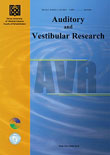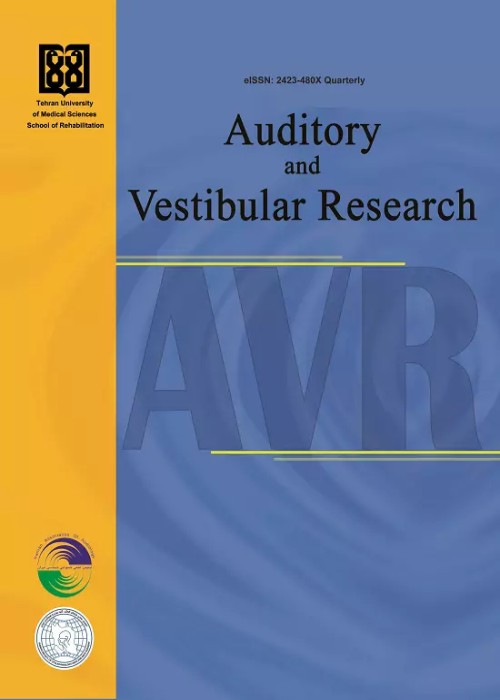فهرست مطالب

Auditory and Vestibular Research
Volume:25 Issue: 1, Winter 2016
- تاریخ انتشار: 1394/11/10
- تعداد عناوین: 8
-
-
Pages 1-6Background And AimHearing impaired students experience binaural hearing like normal peers and school age is challenging time for using dichotic listening. Lack of research was found on relationship of Persian hearing impaired children with central auditory processing (CAP). One of the aims of this study was a comparison between Persian dichotic digit test (DDT) score in children with mild and moderate hearing loss (HL) and normal ones.MethodsForty one hearing impaired children (16 mild HL and 25 moderate HL) and 41subjects with normal hearing all between 7-12 years of age, in both genders (sex has no effect on this test), were selected and tested Persian DDT. Results from Right Ear/Left Ear scores, Right Ear Advantage (REA) and age effect were collected and compared with normal subjects.ResultsResults of this study showed the average of 89.07% correct scores in right ear and 82.24% in left ear. The difference between both ears was 6.83%. Comparison of the right ear correct scores and left ear correct scores showed a significant REA (p0.05).ConclusionThis study pointed out which Persian DDT is not affected by mild-to-moderate sensory neural hearing loss. However, younger children need more interval time between two items to respond to the tests.Keywords: Hearing impairment, Persian dichotic digit test, young children
-
Pages 7-13Background And AimThe quick speech in noise (Q-SIN) test have been designed to evaluate individuals ability to recognize speech in noise. This study established to evaluate the test-retest reliability and equivalency of the five test lists of the Persian Q-SIN test in subjects with sensory hearing loss (SHL) and normal hearing individuals.MethodsThis cross-sectional study was performed on equal number of subjects with normal hearing and SHL, 36 in each group. The participants aged from 18 to 55 years old. The Persian Q-SIN test materials which were recorded on a CD were presented binaurally via an audiometer using standard earphones. For evaluating reliability retest was conducted on the same subjects after three weeks.ResultsThe mean signal-to-noise ratio (SNR) loss was 0.16 (SD=0.70 dB) in normal hearing subjects. There was a significant difference between the mean results of lists 1, 2 and 4 and lists 2, 3 and 4 as well as lists 4 and 5. The mean SNR loss in subjects with SHL was 6.62 (SD=3.20 dB). There was a significant difference between the mean results of list 1 and that of lists 3, 4 and 5 (pConclusionLists 3 and 5 as well as lists 2 and 5 are reliable and equivalent for determining SNR loss in individuals with normal hearing and SHL individuals.Keywords: Quick speech in noise test, reliability, list equivalency, Persian
-
Pages 14-23Background And AimTinnitus retraining therapy (TRT) comprises comprehensive educational counseling and sound therapy. The aim of this study was to compare the effectiveness of TRT relative to a simplified version of TRT (sTRT). Simplified TRT is different from TRT in the duration and type of the educational counseling (shorter) but is similar to TRT in the application of sound therapy.MethodsThis was a retrospective service evaluation survey and the data were collected from 12 consecutive patients who received TRT and 12 patients who received sTRT. The average duration of tinnitus was six years (SD=7.9) with a range between one month and 30 years. All patients received between three and six months of treatment, which typically involved three to four appointments.ResultsThe results showed that scores on the Tinnitus Handicap Inventory (THI) and the visual analog scale of tinnitus loudness, annoyance and effect on life declined significantly (improved) for both TRT and sTRT groups (pConclusionThe results suggest that the duration and type of counseling does not play a critical role in treatment outcome and sTRT may be used when time constraints do not allow the full treatment.Keywords: Tinnitus retraining therapy, tinnitus rehabilitation, decreased sound tolerance, hearing disorder
-
Pages 24-31Background And AimAge implantation is one of the effective factors on speech production outcomes in cochlear implanted (CI) children. The purpose of this study is to determine the role of age implantation on formant frequencies and production of three Persian vowels including /a/, /u/, /i/ in CI children.MethodsSixty nine congenitally deaf children who received CI were divided into three groups based on their age implantation. The first and second formant frequencies of vowels, as dependent variables, were measured by SFS software 1.2. The role of childrens age implantation and their gender, as effective factors, were analyzed using a 3 (implantation groups)×2 (gender) two-way ANOVA with a post hoc Bonferroni honest significant difference test in SPSS 16.0.ResultsThe mean values of F1/a/, F2/a/, F2/u/, F1/i/, F2/i/ were significantly different among different groups (pConclusionEarly age implantation (before 2) can cause an improvement of vowel production due to enhancement of F1 and F2 placement which is related to height and back-to-front movements of the tongue. Also, age implantation predicts the quality of vowel production.Keywords: Cochlear implant, age implantation, formant frequency, vowel
-
Pages 32-38Background And AimThe elderly afflicted with hearing loss experience the consequent problems of falling and imbalance. Some reasons have been reported for the relationship between hearing loss and imbalance. However, a large part of the population of the elderly does not experience hearing assessments and if such assessments are done, the right rehabilitation services are not offered. This study aimed to analyze the research information in which implying the relationship of hearing loss with imbalance and falling in the elderly had been investigated.Recent FindingsThe search for the information was done for the time span of 1989 to the July of 2015.The result of the conducted search included 574 articles on imbalance, falling and hearing loss. After removing duplicates and review of titles and abstracts of articles as well as compliance with the inclusion and exclusion criteria, the articles were studied in details. Among the reviewed articles, 36 relevant articles with either direct referring to the relationship between hearing loss and balance and falling or indirectly related matters discussing the issue in other forms were extracted. Eleven articles which have directly referred to the issue have finally been selected.ConclusionThe results of this review study showed that the hearing loss of the elderly can be one of the factors leading to their imbalance and falling.Keywords: Hearing loss, imbalance, postural control, falling, the elderly
-
Pages 39-48Background And AimThe video head-impulse test (vHIT) measures the vestibulo-ocular reflex (VOR) driven by each semicircular canal, following high-acceleration head rotations. The main measurable response is the ratio of eye movement velocity to the angular head velocity, which reflects canal function. Although normative data is available for VOR gain, most studies only report horizontal VOR characteristics, ignoring variations in vertical plane VOR gains. The purpose of this study was to establish normative data for future comparisons of vestibulopathy patients.MethodsVestibulo-ocular reflex gain and refixation saccades were assessed across 50 healthy individuals between the ages of 20 and 64, without any previous or current vestibular disorders, by applying and measuring horizontal and vertical head impulses.ResultsThe mean VOR velocity gain was 0.96 (SD=0.11) and 0.93 (SD=0.17) for the horizontal and vertical canals, respectively. The variation of the gain in right anterior/left posterior and left anterior/right posterior movements appeared to be wider than in the laterals, but the results were not influenced by direction (p>0.05). Refixation saccades occurred in 7.2 percent of all impulse trials, with a majority occurring covertly in lateral canals. Unlike saccades (more often observed in subjects older than 50), the VOR velocity gain varied independently of age.ConclusionThe findings suggest these gain values can be used to determine VOR deficits in patients. vHIT values are affected by different factors, especially in the vertical plane, so further study is needed to confirm normal ranges of vertical vHIT values.Keywords: Head impulse test, vestibulo, ocular reflex, semicircular canals, eye movement
-
Pages 49-54Background And AimGiven the prevalence of selective auditory attention deficit in children with learning disability (LD) and the need for standardization of screening tests and diagnosis of this deficit in our country, the aim of this study was development and determination of the validity of monaural selective auditory attention test "mSAAT" in Persian.MethodsThis study was a test development based on cross sectional method that was performed in two steps, development and validation of the test and then the initial study. A four minute story and two lists of 25 mono-syllabic words from Persian word intelligibility by picture identification test was recorded by a male speaker. To maximize difficulty a 0 dB signal to noise ratio was used. After validity evaluation, 27 normal and 7 LD children aged 8 to 9 years were tested in both competitive and non-competitive manner.ResultsPersian version of mSAAT had content-validity ratio of 0.91, 0.94, 1.00 for the first and second list and competing story respectively, and content-validity index of 0.88 was calculated for the whole test. Face validity was 4.16 and also significant difference was observed between test scores of the two groups of normal subjects and subjects with LD (pConclusionBased on the obtained result, the Persian version of mSAAT appeared to have the potential as a valid measure of selective auditory attention skill and seems that its the same as the original test.Keywords: Learning disability, monaural selective auditory attention test, selective auditory attention
-
Pages 55-62Background And AimDichotic digit test (DDT) is a valid neuropsychological tool for determining the dominant hemisphere in verbal processing; therefore, the main goal of this research was designing and investigating the psychometric properties of DDT in a sample of Iranian children and then measuring its concurrent validity using the n-back task.MethodsThe present study was a descriptive and psychometric research which was conducted using correlations. 144 children aged between 7-12 years were selected through purposive sampling. To collect data, a DDT which was designed based on the original Persian version of the main dichotic test and validated via the n-back test was also used. Data was analyzed, and the concurrent and descriptive validity of the test was determined using descriptive and inferential statistics as well as correlation and analysis of variance.ResultResults showed that the DDT has acceptable and valid psychometric properties; the Cronbach's Alpha level of 79% shows the concurrent validity of this test. Meanwhile, with an increase in age, the scores at three measuring scales of this test, i.e. right ear, left ear, and differentiation scale also increased. There was no significant difference between the scores of male and female participants.ConclusionIt was shown that the DDT which is known to reflect the hemispheric asymmetry in processing verbal information has appropriate psychometric properties among Iranian children, and proved to be applicable in various clinical and research conditions.Keywords: Dichotic digit test, children, design, psychometric properties, validating


